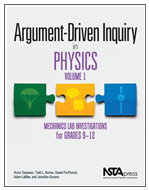Argument-Driven Inquiry for the High School Physics Classroom
By Carole Hayward
Posted on 2017-12-27
 Argument-Driven Inquiry in Physics Volume 1, Mechanics Lab Investigations for Grades 9–12 is the latest addition to the popular NSTA Press Argument-Driven Inquiry (ADI) series. The book includes 23 field-tested labs, along with reproducible student pages, teacher notes, and detailed instructions for running lab investigations, all designed to make it easier to teach complex concepts.
Argument-Driven Inquiry in Physics Volume 1, Mechanics Lab Investigations for Grades 9–12 is the latest addition to the popular NSTA Press Argument-Driven Inquiry (ADI) series. The book includes 23 field-tested labs, along with reproducible student pages, teacher notes, and detailed instructions for running lab investigations, all designed to make it easier to teach complex concepts.
The authors, who are veteran teachers, want to shift instruction from students’ passively receiving information to instead learning how to ask questions and determine conclusions.
“Traditional instructional approaches, which were designed to help students ‘learn about’ the concepts, theories, and laws of science rather than how to ‘figure out’ how or why things work, were not created to foster the development of science proficiency inside the classroom,” the authors write in the book’s introduction.
Times are changing. The innovative and engaging ADI approach focuses students on the practices of questioning, data analysis, argument development, evaluation, double-blind peer review, and report revision—all of which can prepare students for real-world application in a science career, while also meeting current science instructional standards.
“To help students become proficient in science in ways described by the National Research Council in A Framework for K–12 Science Education, teachers will need to use new instructional approaches that give students an opportunity to use the three dimensions of science to explain natural phenomena or develop novel solutions to problems,” the authors state.
The field-tested labs cover topics related to mechanics, including forces and interactions, energy, work, and power. Each lab is designed to help students to understand the disciplinary core ideas in the physical sciences, to use crosscutting concepts that span across various scientific disciplines, and to learn how to use fundamental scientific and engineering practices.
“Current research suggests that all students benefit from three-dimensional instruction because it gives all students more voice and choice during a lesson and it makes the learning process inside the classroom more active and inclusive,” the authors state.
The ADI approach promotes and supports three-dimensional instruction because it gives students an opportunity to construct and critique claims about how things work or why things happen. The labs can provide ways to make physics instruction more authentic and meaningful for students. In addition, the lab activities will allow students to develop the literacy skills outlined in the Common Core State Standards for English Language Arts by creating presentations, reports, and evaluations.
Read the sample lab “Falling Objects and Air Resistance: How Does the Surface Area of a Parachute Affect the Force Due to Air Resistance as an Object Falls Toward the Ground?”
Also check out the Student Lab Manual for Argument-Driven Inquiry in Physics, Volume 1: Mechanics Lab Investigations for Grades 9–12 by Victor Sampson, Todd L. Hutner, Daniel FitzPatrick, Adam LaMee, and Jonathan Grooms.
Follow NSTA
Disclaimer: The views expressed in this blog post are those of the author(s) and do not necessarily reflect the official position of the National Science Teaching Association (NSTA).

